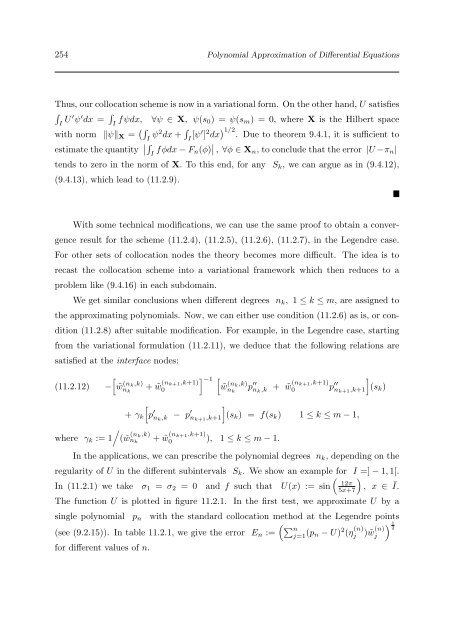Untitled - Cdm.unimo.it
Untitled - Cdm.unimo.it
Untitled - Cdm.unimo.it
Create successful ePaper yourself
Turn your PDF publications into a flip-book with our unique Google optimized e-Paper software.
254 Polynomial Approximation of Differential Equations<br />
Thus, our collocation scheme is now in a variational form. On the other hand, U satisfies<br />
<br />
I U ′ ψ ′ dx = <br />
I fψdx, ∀ψ ∈ X, ψ(s0) = ψ(sm) = 0, where X is the Hilbert space<br />
w<strong>it</strong>h norm ψX = <br />
I ψ2dx + <br />
I [ψ′ ] 2dx 1/2 . Due to theorem 9.4.1, <strong>it</strong> is sufficient to<br />
estimate the quant<strong>it</strong>y <br />
I fφdx − Fn(φ) , ∀φ ∈ Xn, to conclude that the error |U −πn|<br />
tends to zero in the norm of X. To this end, for any Sk, we can argue as in (9.4.12),<br />
(9.4.13), which lead to (11.2.9).<br />
W<strong>it</strong>h some technical modifications, we can use the same proof to obtain a conver-<br />
gence result for the scheme (11.2.4), (11.2.5), (11.2.6), (11.2.7), in the Legendre case.<br />
For other sets of collocation nodes the theory becomes more difficult. The idea is to<br />
recast the collocation scheme into a variational framework which then reduces to a<br />
problem like (9.4.16) in each subdomain.<br />
We get similar conclusions when different degrees nk, 1 ≤ k ≤ m, are assigned to<br />
the approximating polynomials. Now, we can e<strong>it</strong>her use cond<strong>it</strong>ion (11.2.6) as is, or con-<br />
d<strong>it</strong>ion (11.2.8) after su<strong>it</strong>able modification. For example, in the Legendre case, starting<br />
from the variational formulation (11.2.11), we deduce that the following relations are<br />
satisfied at the interface nodes:<br />
<br />
(11.2.12) − ˜w (nk,k)<br />
nk<br />
+ γk<br />
<br />
where γk := 1 ( ˜w (nk,k)<br />
nk<br />
+ ˜w (nk+1,k+1)<br />
−1 <br />
0<br />
˜w (nk,k)<br />
nk<br />
p ′′ nk,k + ˜w (nk+1,k+1)<br />
0 p ′′ <br />
nk+1,k+1 (sk)<br />
<br />
p ′ nk,k − p ′ <br />
nk+1,k+1 (sk) = f(sk) 1 ≤ k ≤ m − 1,<br />
+ ˜w (nk+1,k+1)<br />
0 ), 1 ≤ k ≤ m − 1.<br />
In the applications, we can prescribe the polynomial degrees nk, depending on the<br />
regular<strong>it</strong>y of U in the different subintervals Sk. We show an example for I =] − 1,1[.<br />
In (11.2.1) we take σ1 = σ2 = 0 and f such that U(x) := sin<br />
12π<br />
5x+7<br />
<br />
, x ∈ Ī.<br />
The function U is plotted in figure 11.2.1. In the first test, we approximate U by a<br />
single polynomial pn w<strong>it</strong>h the standard collocation method at the Legendre points<br />
(see (9.2.15)). In table 11.2.1, we give the error En :=<br />
for different values of n.<br />
n j=1 (pn − U) 2 (η (n)<br />
j ) ˜w (n)<br />
j<br />
1<br />
2
















